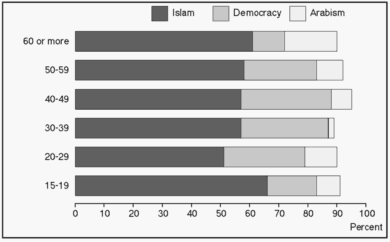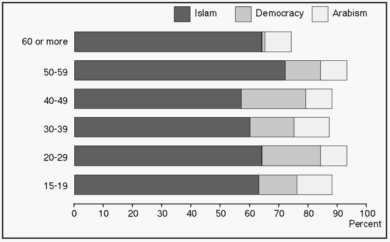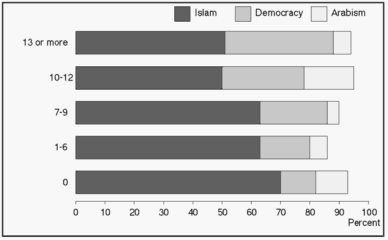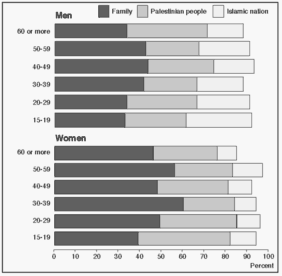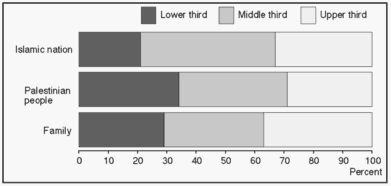
|
||||||||||||||||||||||||||||||||||||||||||||||||||||||||||||||||||||||||||||||||||||||||||||||||||||||||||||||||||||||||||||||||||||||||||||
Political AttitudesBecause political attitudes are exceedingly sensitive in the occupied territories, the survey did not attempt to poll Palestinian political affiliations. It was thought that any endeavour to do so would prejudice the survey as a whole by suggesting a political motivation behind the study. However, because of the political complexity of the region, Palestinians have been subject to a range of disparate, at times conflicting, ideologies and claims to loyalty, some of which have long historical precedents, others which are of more recent origins and all of which are competing for a constituency in order to help shape the future contours of Palestinian society. Therefore, the survey did try to assess the effects of the political forces that are contending in the region to gain individual political sympathies and shape identities.
Figure 9.12 What is the main attribute you wish to see in a future palestinian state political preferences by gender The survey contained three explicitly political questions. The first tried to determine broad political preferences. The question posed a range of alternative attributes - Arabism, Islam, democracy and socialism - and asked the respondent to select the one attribute he or she though most important in a future Palestinian state. The second question listed a range of countries representing different political systems and asked the respondent to choose the model he or she felt best suited for Palestine. The question aimed not only at determining political sympathies, but also at examining the familiarity that Palestinians had of the outside world and the political options it contained. The final question tried to explore the boundaries of ultimate political loyalty and the primary determinant of identity. Here the respondent was requested to choose one cause for which he or she was willing to make the ultimate sacrifice. The choices ranged from the family, the Palestinian people, the Arab nation to the Islamic nation.
Figure 9.13 Men's political preferences by age groups In assessing Palestinian political values the data suggests that Islam is by far the single most important attribute valued by Palestinians. Islam is the majority response of all Palestinians regardless of age, gender, education, locality of residence, refugee status and socio-economic position.
Figure 9.14 Women's political preferences by age groups Support for the more traditional ideology of Arab nationalism is relatively weak among Palestinians although it enjoys the support of 9% of the population. However, support for notions of socialism, a current of thought which during the late 1960s and early 70s had a certain constituency in the Middle East, is almost non-existent. Most notable is the finding that support for Islam is some three times stronger than support for democracy, with Islam more strongly represented among women and democracy more strongly represented among men.
Figure 9.15 Political preferences by educational level, for men With regard to Islam's support among women, two aspects need to be mentioned. First, Islam can be understood in at least two different ways. It can be understood as a religious belief and practice, primarily a matter of scripture. It can also be understood as a political framework, primarily a matter of law, government and society. Survey results suggest that women tend to see Islam more in terms of religious orthodoxy than of political activism. Second, in comparison to men, women seem less politicised and consequently their understanding of various political options tends to be more restricted. Therefore, there are indications that to some extent women overwhelmingly have chosen Islam because this is the attribute with which they are most familiar.
Figure 9.16 Political preferences by educational level, for women When political preferences are broken down by age groups, the data indicates that majority preference for Islam goes through all age categories, but that there is a very marked resurgence of Islamic sentiment among the youngest age group of men. Reversely, for both men and women in this age group, there has been a sharp decline in democratic attachments. When the impact of education on political preferences are examined, the data suggests that education serves more than any thing else to strengthen democratic preferences. Two trends are noticeable. First, with increased education, the value placed on Islam seems to decrease. However, while support for Islam might be less, survey results also indicate that it is probable that the definition of Islam shifts under the educational process from primarily a religious belief to more of an activist political creed. Second, support for democracy is three times more frequent among those with the highest education than among those with the least, confirming the trend not only toward secularisation, but also toward acceptance of plurality and tolerance as mentioned in a previous chapter. If examined together, the data indicates that education is a strong promoter of democratic values. The steep decline in such values among the youngest age group of Palestinian men and the abrupt shift to Islamic preferences could be one effect of the prolonged disruption of education for this age group during the intifada. Socio-economic position also seems to affect political values. The upper one third of Palestinian society express more sympathy for Arabism (12% versus 6% for the bottom third), relatively less for Islam and relatively more for democracy. Particularly among women, the trend toward increasing preference for democracy with increasing prosperity is marked. Islamic preferences are again more associated with the middle economic strata of Palestinian society, a point which will be returned to shortly. Whether or not the household has refugee or non-refugee status seems to have no effect on political values except that non-refugees lean somewhat more toward Arabism (11% of non-refugee versus 7% of UNRWA refugees). The distribution of political values between different types of localities presents a very intricate picture although in every locality gender differentials are apparent. Figure 9.17 lists the types of localities that are most associated and those that are least associated with the various political preferences examined. Within the localities not listed, preferences are broadly distributed in a manner more or less representative of the Palestinian population generally. Because of the disparities between men's and women's preferences, the list has been broken down by gender.
Figure 9.17 Localities most associated and least associated with specific political preferences
Figure 9.17 again indicates that Islamic preferences are not particularly associated with Gaza, but more with the West Bank. Surprisingly perhaps, Gaza male camp residents appear more similar in political values to men in Arab Jerusalem than to men in the West Bank. A previous study has suggested a relationship between arrest records of household members, used as an indirect measurement of political activism, and the political attitudes of household members.4 This survey found no such correlation with reference to political values.
Do Palestinians find inspiration in the political systems of other countries
and do their political values lead them to look to other countries for confirmation
of these values? The survey provided respondents with seven different models
together with the optional category of "none of the above".
Table 9.9 Which of the following countries is the most suitable model for a future Palestinian state by gender
The final question relates to a more fundamental pillar of political life. It involves the boundaries of ultimate loyalty and the definition of political identity. Nationalism is premised on the imperative that cultural (national) boundaries and political boundaries should coincide. A corollary of this premise is that the individual owes his strongest loyalty to the nation and that his political identity is principally shaped by his nationality. The nationalist doctrine insists that both local loyalties and those that transcend national boundaries should be subordinated to the nationalist imperative. In the Middle East the ethnic nationalist message has never had the precision as it has had in its western home of origins where for at least the last 150 years it has operated to replace empires with states claiming to be nationally based. In the Middle East local and family loyalties have remained strong and, partly because of a shared language and religion which transcend state and even regional borders, the definition of a common identity has had to deal with many contending meanings. The Arabic language reserves the word for nation - umma - for the Arabic and Islamic nation solely. Syrians, Palestinians, Lebanese and so forth refer to themselves generically as peoples - sha'b - rather than nations. Thus the question aimed at mapping the levels of ultimate loyalty among Palestinians and relating this map to the pattern of political values described previously.
Figure 9.18 For whom would you be willing to make the ultimate sacrifice? Political loyalties by gender The answers reveal that family loyalties, particularly among women, are still an exceedingly vigorous source of identification. Not unexpectedly perhaps in light of Palestinian history, attachment to the concept of Arab nationalism which has been a prime mover, especially in the Fertile Crescent, for most of the century and is still ardently advocated by key Arab leaders, is conspicuously weak among Palestinians. The 9% support of Arabism as a prime political preference does not translate into a political constituency for Arab nationalism. Instead, adherence to this allegiance seems to have been replaced, first and foremost, by loyalty to the Palestinian cause. Especially among men, attachment to emerging forms of Islamic identity is very notable. The distribution of family loyalties and loyalties to Palestine and Islam for men are examined by type of locality, and presented in Figure 9.19.
Figure 9.19 Menšs ultimate loyalties by type of locality The figures indicate that local family loyalties remain strongest in Arab Jerusalem and Gaza Town and weakest in the Gaza refugee camps. The low correlation with the Gaza camps may reflect the extent to which wider family units have been splintered and the subsequent penetration of more explicitly politically defined sentiments, especially Palestinian nationalism. However, again the figures show that Islamic militancy is not particularly associated with Gaza. The figure would suggest that such militancy is more developed in the refugee camps of the West Bank. If these loyalties are examined in relation to age, the picture that emerges confirms trends seen elsewhere in this chapter (Figure 9.20).
Figure 9.20 Ultimate political loyalties by age groups The young express less attachment than the middle-aged to family bonds and more attachment to bonds that are ideologically delineated. The increase in identification among young women with Palestinian nationalism is particularly marked. 43% of women in the age group 15 to 19 name the Palestinian people as their ultimate attachment compared to 34% of women in general. Loyalty to Islam among women seems not to be affected by age, but has broadly the same size of constituency in all age groups.
Table 9.10 Ultimate loyalty by arrest record of household members
The picture that emerges from men's responses indicates different trends. The data suggests that among younger men loyalties are shifting from the family to Islam with the inroads of Islamic militancy most marked in the youngest age group. A comparison between the answers of young women and men suggests almost a feminisation of the Palestinian national movement. Currently, Palestinian nationalism seems to be recruiting many more of its most devoted adherents from the ranks of young women, rather than young men. In relation to the inroads of Islamic militancy, again age, more than education, seems to have the greater impact. Except for men with no education, educational levels do not seem to affect political loyalties. For instance, whereas 32% of the best educated men defined their primary loyalty as Palestine and 27% as Islam, among those with only 1 to 6 years of education, 27% state Palestine and 23% Islam. The picture is similar for women. Ultimate political identities and loyalties seem to remain largely unaltered by the educational process. Unlike political preferences, ultimate political loyalties have a clear association with economic status. The relationship can be seen by looking at the economic background of individuals with different political loyalties (Figure 9.21).
Figure 9.21 Political loyalties by economic strata This figure demonstrates that those whose primary loyalty is focused on the family or the Palestinian national movement come more or less equally from all economic strata. Contrary to commonly accepted views, however, this table would suggest that Islamic militancy is not primarily generated by economic deprivation and distress. Islamic militants are more commonly drawn from the upper, but especially the middle, economic echelons of the Palestinian population. In this respect Islamic activists are very similar to ethnic nationalist activists to whom they are structurally and ideologically akin. Like ethnic nationalism, the data suggests that the Islamic movement is not so much fuelled by despair as it is fed by the frustrations of the middle sections of society, especially the frustrations of young, reasonably educated individuals whose upward mobility in society is blocked. The inability of many Palestinians to translate their education into white collar employment is one such block. But the most important one is the occupation regime itself.
It has frequently been noted that the Israeli policy of mass detention has
functioned to transform Israeli detention centres and prisons in the occupied
territories into advanced training centres for political activists. A comparison
of the responses of those individuals who had at least one of the members
of their household arrested during the period of the intifada could suggest
tentatively that the experience has had a politicising effect and the effect
is uniformly in one direction, a reinforcement of Palestinian loyalties.
Islamic sentiments appear to remain unaffected.5 |
||||||||||||||||||||||||||||||||||||||||||||||||||||||||||||||||||||||||||||||||||||||||||||||||||||||||||||||||||||||||||||||||||||||||||||
 al@mashriq 960428/960710 | ||||||||||||||||||||||||||||||||||||||||||||||||||||||||||||||||||||||||||||||||||||||||||||||||||||||||||||||||||||||||||||||||||||||||||||

